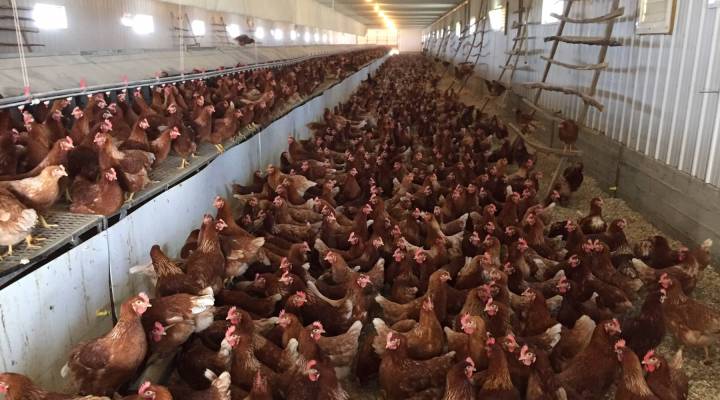
To free your hens or not? That’s a big question

Over the past year, the list of companies pledging to switch to cage-free eggs has expanded dramatically. According to the U.S. Department of Agriculture, 40 grocery chains, including the likes of Albertson’s and Wal-Mart, 39 restaurants, such as McDonald’s and Burger King, and a raft of food manufacturers and distributors are going cage-free.
Animal rights groups have lobbied hard for the shift to cage-free production. In conventional battery cages, the amount of space that hens have to move around on is equivalent to about the size of a tablet.
But at this point, only about 10 percent of production is cage-free.

The USDA says that to meet current and future demand for cage-free eggs, farmers will need 175 million cage-free hens in production. Today, the agency estimates there are only about 18 million.
To make up that huge differential, farmers like Amon Baer might need to go cage-free.
In April, he attended a poultry convention in St. Paul, Minnesota, and was going to investigate making a shift.
“I’ll be looking at cage-free equipment versus caged equipment, and I’ll be assessing the costs,” he said.
Baer comes from a big farming family in northern Minnesota. He and his brothers and nephews together have more than a million layer hens.
Baer’s own share of that total used to be about 300,000, but he lost a lot of hens to bird flu last year.
The fact that Baer was going to scope out cage-free systems seemed significant. His family has used cages since 1965. And Baer has publicly decried efforts to force farmers to ditch conventional cages in states like California, making him no friend of the Humane Society.
“I would question how many of those people in the Humane Society that are advocating for it have grown up in the egg business and have actually taken care of birds and livestock,” he said.

Cage-free, organic hens wander outside at Goede Acres farm in western Wisconsin.
Baer has a lot of reservations about going cage-free. For one thing, he said, the bird mortality rate is a lot higher.
“When you have thousands of birds in a building on the floor, where they have access to run all around, they can be cannibalistic and kill each other,” he said. “And they do so.”
Labor costs can climb with cage-free systems because more workers are needed to manage the flocks, handling tasks like collecting eggs that hens lay outside their nests. There’s also potentially a big capital investment: Farmers may need new buildings and equipment to keep as many hens. And feed costs spike — when hens move around more, they eat more, especially in systems called aviaries, where the hens can move up and down onto different levels.
Researchers working with the Coalition for Sustainable Egg Supply estimate aviary costs run 30-40 percent higher than conventional cage systems.
Amon Baer and some agriculture economists worry that consumers will not like having the higher costs of cage-free eggs passed on to them.
The national average advertised price of a carton of large conventional eggs currently runs in the neighborhood of $1 a dozen. Cage-free eggs, meanwhile, run more like $3 a dozen.
A tiny slice of the cage-free supply comes from father-and-son team Lorn and Joel Goede in Viroqua, Wisconsin. They have 10,000 layer hens.
“We never even considered a caged facility,” said Lorn Goede.
“The idea of having chickens in cages didn’t excite either one of us,” added Joel Goede.

Father and son team Lorn and Joel Goede launched an organic egg operation in 2003 in western Wisconsin.
Joel Goede said they haven’t had big problems with the hens treating each other aggressively. He pointed to a series of ladder-like structures along the barn wall, called roosts, which the hens can fly onto. Goede said if you give the birds things to do, like roosting, they peck less at each other.
“We’ve had 26 flocks now, and I can’t say we’ve ever had a time where aggression was an issue,” he said
The Goedes’ eggs are not just cage-free but also organic. The hens get outdoor access and organic feed, which costs more.
Those added benefits are reflected in the cost of the eggs. The average advertised national price of organic brown eggs is currently running about a dollar per dozen higher than cage-free eggs.
The co-op the Goedes belong to, Organic Valley, said demand for those organic eggs is nevertheless outpacing supply. But it wasn’t clear that would be the case when the Goedes built their hen houses in 2003.
“There wasn’t a guaranteed market like there was today. It was a huge leap of faith,” said Joel Goede.
For his part, Amon Baer is still not willing to make a leap of faith and go cage-free. After investigating his options at the poultry convention in April, he decided to pass. Baer said he’s concerned that there is still no common standard for what counts as cage-free.
“What happens if I put $40 a bird into these aviary systems?” he said. “And five years down the road some certifying organization says, ‘We no longer accept that; that’s not good enough’?”
There’s a lot happening in the world. Through it all, Marketplace is here for you.
You rely on Marketplace to break down the world’s events and tell you how it affects you in a fact-based, approachable way. We rely on your financial support to keep making that possible.
Your donation today powers the independent journalism that you rely on. For just $5/month, you can help sustain Marketplace so we can keep reporting on the things that matter to you.












